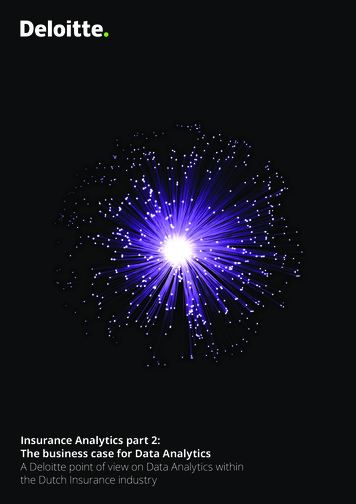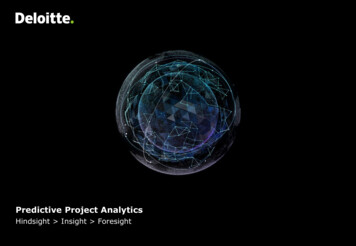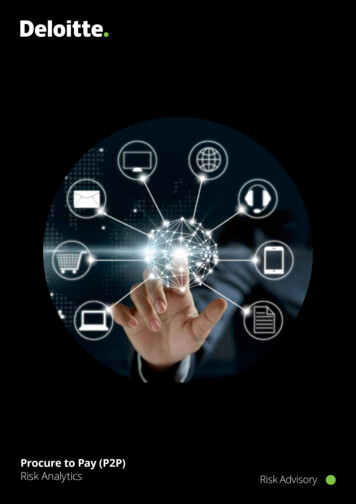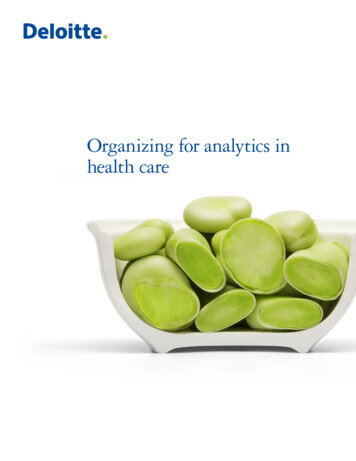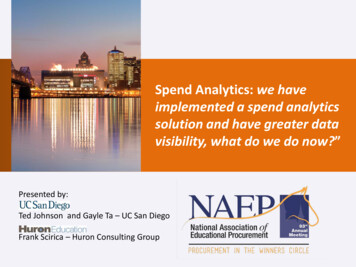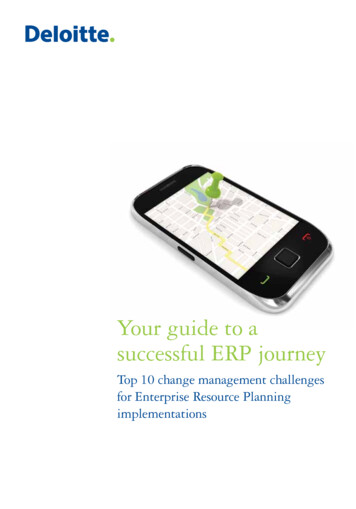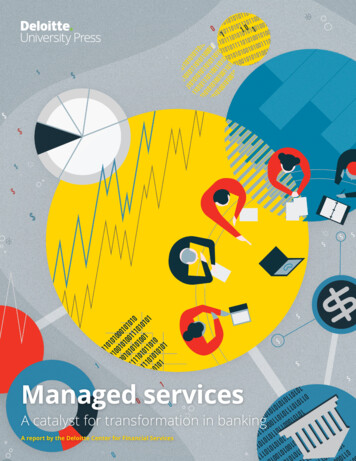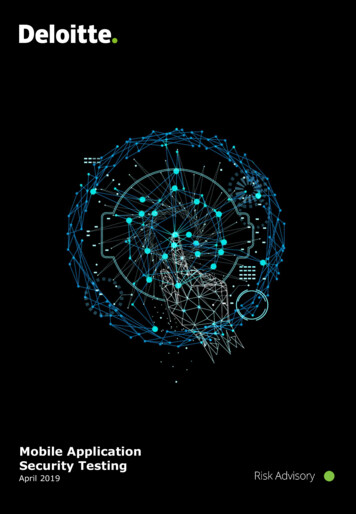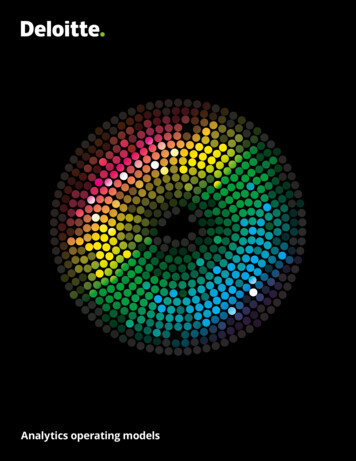
Transcription
Analytics operating models
Analytics operating modelsEvolving analyticsoperating modelcan help advancecompanies’ digitalpriorities2
Analytics operating modelsOrganizations across industriesand borders are continuingto invest in analytics to gleancustomer and operationalinsights from their data. Fiftynine percent of respondents toDeloitte’s 2018 Global CIO Surveyidentified artificial intelligence andmachine learning (AI/ML) as theirorganization’s top investment area.Cloud-based data platforms andanalytics services have made iteasier and more cost-efficientto access analytics technologiesthrough flexible consumptionmodels. According to the DeloitteTMT Prediction 2019 report,companies will accelerate their useof cloud-based AI software andservices. Among companies thatadopt AI technology, 70 percentwill likely obtain AI capabilitiesthrough cloud-based enterprisesoftware, and 65 percent will likelycreate AI applications using cloudbased development services.3
Elevating operatingAnalyticsthe humanmodelsexperience using cloudEmerging trendsdrive increasing needfor data analyticsAmong the emerging trends driving organizations’ increasingneed for advanced analytics:Data growth and proliferationCloud and flexible consumptionFuture of workRapid digitization of processes, thephysical-digital-physical loop of data, anddigital exhaust from intelligent productsare creating high volumes of siloed data.(IDC predicts the total volume of datastored electronically in 2020 to be around44 zettabytes; the same value was 33zettabytes in 2018.1) This data, proliferatingacross the value chain in customerrelationship management (CRM); configure,price, and quote (CPQ); enterprise resourceplanning (ERP); and other on-premise andcloud enterprise systems, creates bothopportunities and risks for organizations.Combing through it enables companiesto develop more targeted products andservices, enhance feature sets, offer richcustomer service, and more. However, thedata’s sheer volume and siloed nature oftenleads to multiple sources of truth, lack oftrust in data and metrics, and significantsecurity risk.Deloitte CIO survey respondents statedthat they plan to dedicate nearly half oftheir IT spending to cloud, which representsan increase of more than 20 percent fromthe previous year.2 CIOs also noted thatorganizations are shifting from on-premisemodels to flexible consumption modelsin almost all cloud technology use casesto enable a growth agenda, improvebusiness agility, and increase scalability.Accelerating connectivity and increasinglypowerful cognitive tools are changingthe nature and future of work. Cloud,automation, and AI are making it easierfor business professionals to scout,implement, and maintain technologywithout intervention from IT staff and,in the process, redefine organizationalroles and responsibilities. For example, byusing prebuilt cloud solutions, businessprofessionals in multiple industries aremanaging real-time exceptions of orderprice with minimal IT staff assistance.“Accelerating connectivityand increasingly powerfulcognitive tools arechanging the nature andfuture of work.”4Cloud computing is emerging to be aforce multiplier in the data and analyticsspace to create more opportunitiesfor enterprises, including: Easy access to preconfiguredanalytics solutions and big dataplatforms. Leading cloud providersoffer an inexpensive way to accesspreconfigured, scalable, AI/ML–readysolutions that can be spun up in minutes. Efficient integration with a widevariety of sources to enable citizenintegration. Most cloud providershave multiple ways to ingest real-timedata generated from sources such asenterprise applications, websites, mobileapps, and Internet-connected devices. Jump-start self-service analyticsand AI/ML efforts. Readily availablesoftware-as-a-service (SaaS) visualizationsolutions provide easy integration tobig data platforms and AI/ML startermodels via flexible consumption models,a game-changer from a flexibility and totalcost of ownership (TCO) perspective.Already, many technology teams aremoving from traditional project operatingmodels to ones that are more outcomecentric, focused on delivering value ratherthan services. In addition, automationand cloud are streamlining and speedingdelivery, as well as helping to eliminatesome tactical and operational work andmove the rest to machines and serviceproviders. The advancement of borderlesstechnology is also changing the perceptionof IT as the owners of an organization’sdata. As analytics continues to be pushedout from behind the IT curtain into thebusiness, technology SMEs’ primary roleis transitioning from developing reports tofacilitating provision of clean, accurate, andsecure data “on the fly” to business SMEs toaccelerate decision-making.
Elevating the humanAnalyticsexperienceoperatingusingmodelscloud 5
Elevating operatingthe humanmodelsexperience using cloudAnalyticsEvolving toward an analyticsservices operating modelHarnessing the emerging trends of data growth and proliferation, cloud and flexibleconsumption, and future of work can generate rapid changes in an organization’sstructure, operations, and processes. This also enables organizations to transitiontowards an analytics-as-a-service model by shifting from a product to a services-basedoperating model (figure 1).Figure 1. Proposed analytics services operating model of the futureStrategic servicesStrategy and innovationService portfolio and financialsData governance and quality managementService integration and orchestrationFunctional servicesService delivery andsupport servicesBusiness relationship managementBusiness intelligence and analyticsData virtualization and abstractionShared servicesServiceoperationsServicedeliveryTalent managementand trainingInformation architectureContracting, sourcing,and vendor managementData storage and aggregationData security and privacy managementData retention, archive, and dispositionMaster data managementMetadata managementData acquisition and integrationInfrastructure services (compute, storage)6
Elevating the humanexperienceusingcloud AnalyticsoperatingmodelsThe analytics operating model of the future spans strategic, functional, support,shared, and infrastructure services.Strategic servicesService delivery and support servicesInfrastructure services Develop and refine the strategy fordata management and analytics andconduct research on emerging trendsin the market, technology, process,industry, and people Provide service design anddevelopment and program andrelease management execution Include computing and storage Manage initiatives and opportunitiesas a formal investment portfolio Maintain an up-to-date service catalogand manage budget, chargeback,SLAs, and KPIs Ensure service operations and supportin terms of event, incident, servicerequest management, and reporting Procure vendors to support deliveryof services within the organization Recruit, retain, and manageperformance of talentFunctional servicesShared services Work jointly with business functionsto understand their strategy andpriorities Ensure data quality, security, andprivacy Assist business functions to triage,prioritize, and achieve their analyticsgoals Support information architecture anddata modeling Acquire, store, and aggregate datafrom new and existing systems Provide operational reports, selfservice analytics, visualizationprocesses, and tools to automate thegeneration of analytics and insights7
Elevating operatingAnalyticsthe humanmodelsexperience using cloudThe operating model should be coupled with a governance structure (figure 2) that spans business and IT and has as its objectivescentralizing strategy, governance, and technology; optimizing use of analytics talent; monitoring data proliferation caused by businessspinning up new cloud-based analytical tools and processes; and alleviating cloud data and data-in-motion security concerns.Figure 2. Proposed governance structurePrinciples andstrategiesSteeringcommitteeConsists of cross-functional leaders from both business and IT that helpset the strategy, priorities, goals, and measures of success with anenterprise-level lens. Committee may be chaired by an executive sponsor(such as a chief data officer).Policies,standards,and deliveryoversightData governancecouncilWorks with ACoE for development of processes, leading practices,and standards.Analytics centerof excellence (CoE)Consists of cross-functional analytics experts that are responsible forexecution of the analytics strategy and demand management (leadingtechnologies, processes, standards, and oversight of analytics initiatives).Architecture reviewboard (ARB)Works with ACoE for focus on larger technical decisions, including tools,technology, and cross-platform architecture.OperationalteamsFormed within business and IT to work collaboratively to deliver on thedata and analytics agenda. These teams would be composed of bothbusiness (data stewards, data scientists) and technical roles (solutionarchitects, data engineers, data architects).Execution8
Analytics operating modelsPotential benefitsElevating the human experience using cloud According to Deloitte’s Global CIO Survey, organizations are using digital technologiesand capabilities to transform business operations (69 percent) and drive top-line growththrough improved customer experiences.3 Cloud-based data platforms, coupled withservice-based analytics operating models, can support these objectives by:Enabling data democratization to help businesses shift theirvalue proposition from products to ongoing, data-driven services.From R&D and sales to account management and aftermarketservices, cloud-based AI/ML capabilities create opportunities toimprove efficiency and enhance customer experiences, helpingorganizations attract and retain customers, as well as drivesignificant, service-driven value (figure 3). For example, one 4billion storage client shifted to outcome-based services via digitaladoption and to an agile mindset through a common data platform,enabling shared business alignment on “metrics that matter.”Supporting cloud-driven customer-centricity by eliminatingfunctional silos to establish a frictionless customer experience.Customer journey–stage KPIs built on a cloud-enabled, unified dataplatform can facilitate a 360-degree view and a culture of customercentricity. For example, a global communications network companystarted its shift to a customer data strategy as-a-service modelby using a defined customer data management platform to fosterpersonalized and contextual engagement, with the aim of drivinggrowth in customer acquisition and lifetime value.Figure 3. Customer and operational benefitsSalesOperational efficiency Forecast and report across serviceofferings, geographies, and salesterritory Accelerate data-driven operatingmode to transform businessoperations from “transactiondriven” to “engagement-driven” 360-degree customer view based ontrusted data and analytics Ease of performing analytics andthe ability to identify and link datafor insight generation Rapidly test hypothesis with analyticsCustomer supportMarketing 360-degree view of customers Receive near-real-time informationabout issues prior to escalationand visibility into the cross-cloudfunction issues Ability to perform self-serviceanalyticsGovernance Data governance policies,procedures, and organizationalmodel Data-sharing agreementsKEYBENEFITS Ability to collect and report onthird-party metrics and analyzevolume of leads generated to guidemarketing spend Single view for customers acrosscustomer journey phasesCustomer service Align entire business withcustomer journey–stage KPIs toengage customers effectivelyand consistently Clean and standardizedcustomer master data; resolveduplication issues9
Analytics operating modelsMoving forwardThe boundary between business and technology isblurring, accelerating organizations’ move towardan analytics operating model through cloudadoption and an evolving business-IT construct. Thismodel is a key foundational element to help theirorganizations harness emerging trends, developactionable insights, and deliver results and valuemore quickly to business and IT stakeholders.As with any major change, the transition to theanalytics operating model of the future requires ashared vision among key leaders, early identificationand engagement of the right sponsors, and settingbold yet achievable short- and long-term goals.10
Analytics operating modelsEndnotes1.International Data Corporation (IDC), The Digitization of theWorld: From Edge to Core,November 2018, 2.Ibid.3.Deloitte, Manifesting legacy: 2018 global CIO survey, August t GillPrincipalDeloitte Consulting LLPjagjgill@deloitte.comRichard StarnesPrincipalDeloitte Consulting LLPrstarnes@deloitte.comNavin WarerkarManaging DirectorDeloitte Consulting LLPnwarerkar@deloitte.comAnuj SoodSenior ManagerDeloitte Consulting LLPansood@deloitte.comKey contributorWe would like to thank Payal Singh, whohas contributed to this publication.11
About DeloitteDeloitte refers to one or more of Deloitte Touche Tohmatsu Limited, a UK privatecompany limited by guarantee (“DTTL”), its network of member firms, and theirrelated entities. DTTL and each of its member firms are legally separate andindependent entities. DTTL (also referred to as “Deloitte Global”) does not provideservices to clients. In the United States, Deloitte refers to one or more of the USmember firms of DTTL, their related entities that operate using the “Deloitte” namein the United States, and their respective affiliates. Certain services may not beavailable to attest clients under the rules and regulations of public accounting.Please see www.deloitte.com/about to learn more about our global network ofmember firms.This publication contains general information only and Deloitte is not, by means ofthis publication, rendering accounting, business, financial, investment, legal, tax, orother professional advice or services. This publication is not a substitute for suchprofessional advice or services, nor should it be used as a basis for any decisionor action that may affect your business. Before making any decision or taking anyaction that may affect your business, you should consult a qualified professionaladviser.Deloitte shall not be responsible for any loss sustained by any person who relies onthis publication.Copyright 2020 Deloitte Development LLC. All rights reserved.
trusted data and analytics Rapidly test hypothesis with analytics . platform can facilitate a 360-degree view and a culture of customer-centricity. For example, a global communications network company started
